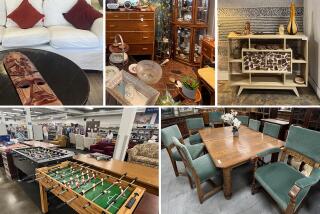Electricity Brightens Design for Lamps
- Share via
Early lights for the home were candle flames or fuel-burning lamps. When the electric light was invented, a new type of lamp could be designed. A closed lampshade was possible because there was no flame and relatively little heat.
In the early 1900s, when Arts and Crafts and mission styles were popular, lamps were made to blend with the heavy, straight, oak furniture. Box-like wooden columns or iron, copper or pottery bases were preferred. Shades were made of metal and translucent mica, parchment, colored glass or pierced pottery. The lamps were short compared with modern versions.
The domed or mushroom-shaped shade and the low wattage of the bulb provided dim illumination. It was barely strong enough to read by.
Question: Our black walnut melodeon is marked “J. & E. Foster, Keene, N.H.” How old is Answer: Joseph Foster started building reed organs such as your melodeon in 1831. He moved from Winchester, N.H., to Keene in 1845. His brother Ephraim joined him in business in 1866, and the company became known as J&E; Foster. The brothers worked together until Joseph’s death in 1875.
Your melodeon was made between 1866 and 1875.
Q: I have a large bottle that looks like a hollow dumbbell. It is made of a silver-colored metal with a small red plastic screw top. Friends think it might be a cocktail shaker from the 1940s.
A: You have a Dumb-bell Shaker, according to advertisements written when it was made in the 1930s.
The popular glass dumbbells were made in dark blue, yellow, green or red. Some had metal stands. Decorated dumbbell shakers also were made.
The chrome-and-glass pieces sell for as much as $450. The plain glass versions sell for $100 to $150.
Q: My white glass mug has a blue picture of Hopalong Cassidy. When was it made?
A: Hopalong Cassidy was a character in a 1907 book. He became so popular that he was in a series of books, movies and television shows.
The glass mug held Big Top peanut butter in the 1960s. The mug had a tin lid.
Q: I have a large stoneware jug with a mark that’s faded to “. . . Norton/Bennington, Vt.”
A: Stoneware jugs and jars were made in several important potteries in Vermont.
The Norton family of Bennington operated one of the state’s best-known stoneware potteries. Capt. John Norton founded the pottery in 1793, but until 1823 the pottery’s wares were rarely marked. Various members of the family worked at the pottery until it closed in 1894. The initials preceding the Norton name changed over the years.
The state name on your jug dates it sometime after 1850.
Early Bennington pieces are popular with collectors and can be worth thousands of dollars.
Q: I was at a show recently where some senator pens were for sale on a table full of pocketknives. What is a senator pen?
A: It is a small penknife with metal sides and two blades. It has one blade at each end. The smaller blade was designed to sharpen quill pens--which is the reason small pocketknives are called penknives.
Many senator pens from the 1930s and ‘40s have advertising engraved on the sides and were given away by storekeepers to customers.
Because senator pens have sides made of metal rather than pearl or some other fancy material, they are not as expensive as some other penknives. They are still made.
Q: My French clock is a bronze sculpture of a woman draped in a vine of roses. In her outstretched right hand she is holding a globe timepiece with pendulum. The sculpture has a plaque on the base that reads, “Eglantine par Aug. Moreau (Medlle D’Or).” History?
A: Auguste Moreau, a bronze sculptor, worked in France from about 1860 to 1910.
Whether Moreau knew that his sculpture “Eglantine” (“wild rose”) would be used as the design for a clock is unknown.
We have seen the same globe-and-pendulum timepiece attached to a similar bronze sculpture by another artist. Both clocks were made about 1900.
If you’d like a listing of helpful books and publications on antiques, send a self-addressed, stamped (55 cents) envelope to the Kovels, Los Angeles Times, King Features Syndicate, 235 E. 45th St., New York, NY 10017.
(BEGIN TEXT OF INFOBOX / INFOGRAPHIC)
Current Prices
Current prices are recorded from antiques shows, flea markets, sales and auctions throughout the United States. Prices vary because of local economic conditions.
* Buster Brown pinback button, advertising Buster Brown Bread, Tige in front of sign, brown, green and yellow, 1 1/2 inches: $30.
* Akro Agate candlestick, inkwell shape, marbleized green and white, 2 inches: $45.
* Fiesta pottery fruit bowl, medium green, 5 1/2 inches: $70.
* Flash Gordon coloring book, 1952: $100.
* Civil War razor kit, sheath, leather strop, tin, Joseph Rogers & Sons: $120.
* Heintz Art metal cigarette box, sterling silver on bronze, flying geese design, brown patina, 7 1/2 by 4 1/2 by 3 1/4 inches: $175.
* Hopalong Cassidy cap gun, gold wash, black grips, Wyandotte: $325.
* Queen Anne-style mahogany bookcase, swan’s neck open pediment, two glazed doors, mirrored back, long drawer, ball and claw feet, 44 by 17 by 80 inches: $350.
* Firestone Bullnose Colson bicycle, girl’s, whitewall tires, circa 1939: $775.
* Hooked rug, figural, American, dated Feb. 14, 1922, striped, scalloped, foliate border, trotting horse center, black, gray, brown, blue, 29 by 39 inches: $1,050.


